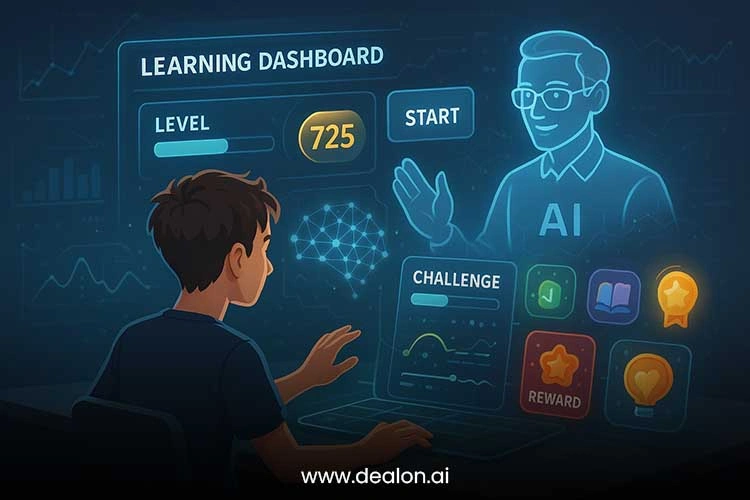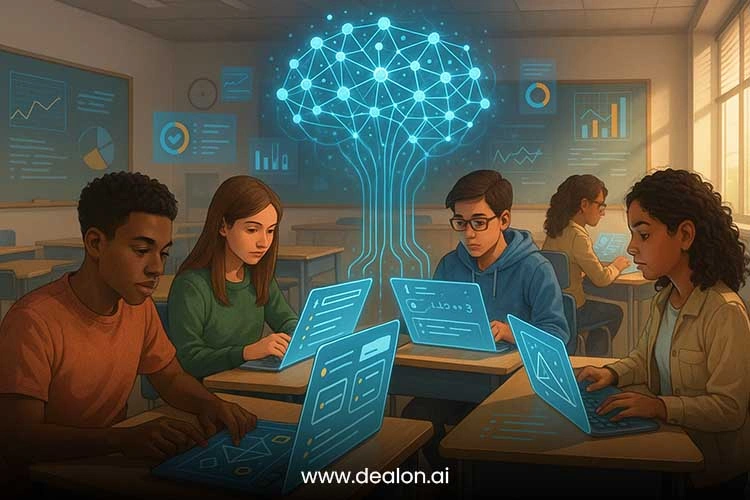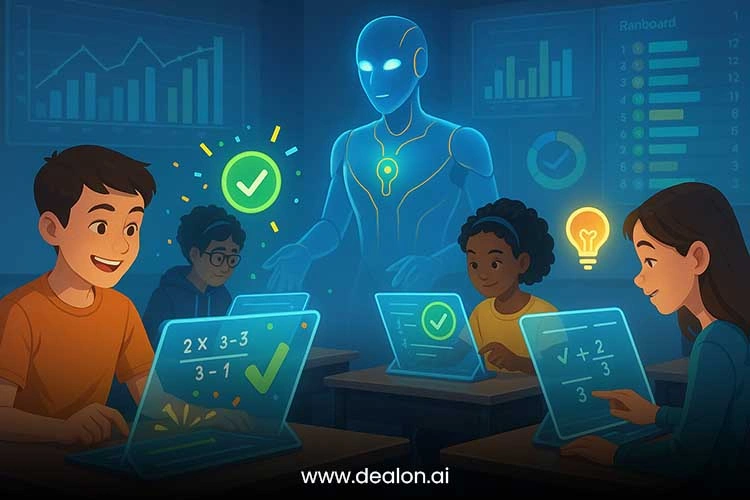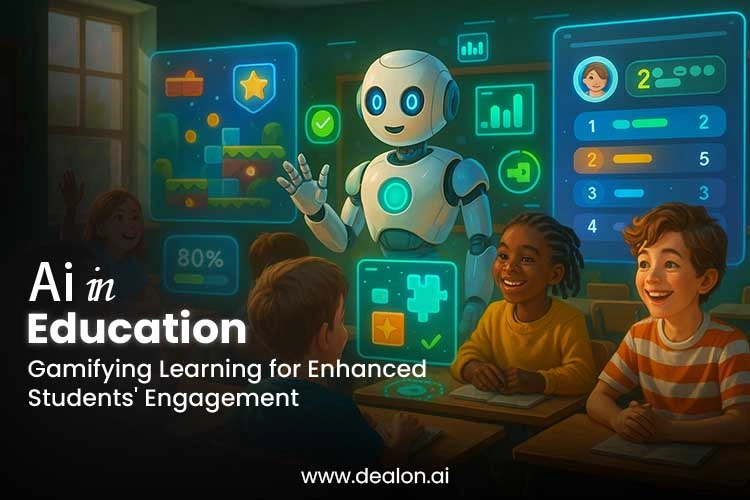In the modern education setting, technology is redefining the limits of the traditional learning approach. The exposure to Artificial Intelligence is also one of the most innovative enhancements in the learning arena. When combined with the idea of Gamification, AI presents an opportunity to change the way students are engaged by converting boring lessons into dynamic and interactive ones. The collaboration of AI and gamified learning in classrooms is bringing the next phase in educational experience, which is not only individual but also absorbing, involving, and self-incentivizing.
Gamification, a method of inserting aspects of games, including rewards, challenges, and progression into the learning process, is already seen as applicable in the further stimulation of students and the increase of their engagement. Nevertheless, when driven by AI, its potential is unlocked. With the support of AI, this type of learning experience can be highly customized, as educators will be in a position to develop adaptive, personal paths through the learning process that acknowledge students’ strengths, weaknesses, and, more importantly, their interests. The fusion enables a very personalized strategy, so that students are kept attentive and challenged at an appropriate level without being overworked or bored.
In addition, the total immersion experience is enhanced by the fact that AI will help to receive instant feedback and keep the learning experience collaborative. Students are no longer leaving their passive content-consuming days behind; they allow themselves to be in touch with the content in forms that are not only constructive but also playful in consolidating knowledge and its use.
With the future in mind, there is yet no limit to the possibilities of Gamification in education where AI will be involved, thus preparing the next generation, who will be more interactive, engaging, and future-ready. It is a game-changing strategy that not only promises to make learning more enjoyable but also more productive, so that they will be better prepared to live and succeed in a very digital environment.
Also Read: OpenAI vs Anthropic: Which AI Models are Leading the AI Race in 2025?
Education AI x Gamification

Artificial Intelligence is the lucky charm of any gamification that may be implemented in education, as this fusion contributes to the best enrollment of students and maximum engagement. Gamification is the direct integration of mechanisms of games like scoring systems, levels, challenges, and rewards, into learning. This creative process not only creates a feeling of success but also further encourages the students to engage actively in their learning process. However, with the addition of AI, the effects of Gamification are multiplied beyond measure. A more personalized and flexible learning will be achieved, and now teaching systems will be constructed around the individual student.
The use of AI in the above intersection is that it keeps analyzing and adjusting to the performance of a student in real time. AI-enhanced systems are able to adapt to the level of difficulty, change the way of content delivery, and even suggest the given type of activity according to the level of student achievement. On an increased level of data-driven insights, AI forms learning patterns, which means that the system will be able to offer a student individual challenges at a pace of his/her studying, cognitive inclinations, and knowledge levels. Such dynamic adaptability is the nature of AI-driven gamification as a revolutionary tool of modern education.
The interaction of the game mechanics and AI creates the possibility where the students are allowed to take risks, make experiments, and learn through trial and error, similar to players in the game. The instant gratification, i.e., getting a virtual badge or progress points, not only strengthens the learning outcome but also the motivation level, as the student will keep working.
Besides this, since this adaptive work pace lets students work at a pace that they want, no learner is left behind, and there is a perfect balance to keep the student on their toes. Put, AI and Gamification are on a collision course in the education sector, setting the scene for entirely personalized, immersive, and highly engaging learning.
Individualized Learning Plans: The Strength of AI-enabled Personalization

Personalised learning is not a new concept in teaching, but what has changed and is now making personalised learning a reality is the development of Artificial Intelligence. The routinization of contemporary education is usually based on a studied program, where very few opportunities are provided that would allow them to develop in the way they need and proceed on an individual schedule.
This blank method can be used to cause withdrawal of more skilled learners or frustration in those who require extra help. AI alters this pattern by enabling the power of data to produce personalized learning pathways and, in such a way, ensure that every student will be provided with an adequate challenge and support depending on his or her particular strengths, weaknesses, and preferences.
This idea of individual learning paths has even greater power in a gamified learning environment. These platforms equipped with AI have the potential to carry out assessments constantly by measuring the level of completion, the grades acquired in quizzes, the time spent, and the involvement levels of a student. Using this data on a real-time basis, the system can regulate the complexity of lessons and present up-to-date challenges, which correspond to the level of competency of the learner.
Example: the student who performs well in a particular subject might be provided with more advanced quests, complex levels, or puzzles to solve his/her day, and the feeling of intellectual challenge will not disappear. On the other hand, a student who may be having difficulty with particular concepts may be provided with lower-level materials and supplemental help that is adapted to their style of learning, which may be by visual things, participation, or directions one step at a time.
Such a dynamic and flexible strategy not only keeps the students alert, driven, and empowered. Instead of being left behind or feeling bored, they are offered activities that not only excite them on the intellectual part of their minds but also in the competitive zone.
The AI-based gamification type of learning is not only personalized but also interactive, making sure that the students are in continuous forward motion without feeling overwhelmed or stuck at a certain point in their learning process. Finally, such an innovative way of personalization establishes a stronger and more profound sense of connection between the students and their studying opportunities, which makes the educational process more effective and entertaining.
Real-Time Feedback: Increasing Motivation and Involvement

Feedback in the traditional classroom is usually slow, and learners have to wait until the teacher goes over their work to offer comments. This is the gap that may give an opportunity to miss learning since students may proceed to keep on making the same mistake without getting immediate guidance or clarification. Nonetheless, there is a paradigm shift with the adoption of Artificial Intelligence in gamified learning settings to an astounding level. The real-time feedback loop that AI offers will allow creating instant actionable feedback and subsequently motivate and engage students.
Among the most critical positive effects of AI-powered feedback, its real-time quality should be mentioned. With the help of a gamified environment, learners are motivated to approach an issue, say some questions, or perform tasks with the agreement that they will get a quick response based on their achievements. When a student makes a wrong answer, the system does not mark it as such and move on; instead, the correct answer, hints, and explanations are offered instantly, or even an alternative methodology is suggested on how to reach a specific solution.
This real-time adjustment enables learners to learn what adverse outcomes and modifications they/ students should make immediately and become flexible in changing their strategies as fast as video game players adapt to the new versions of levels or other challenges the games raise. This real-time answer avoids the frustration that can be common during traditional learning that involves time lag, which may result in misunderstanding and boredom. In gamified learning, AI will make sure that students will not feel stuck in the darkness of not knowing where they made a wrong step or a wrong choice, but will be taken through a process of constant progress.
This two-way feedback spark keeps all the students active because they can observe the improvement each time, which improves their self-esteem and enhances the growth mindset. Moreover, personalizing the learning experience is further achieved by the real-time feedback that is adjusted according to the personal learning patterns.
By automatically simplifying or complicating feedback and tasks as per the performance of the learners, AI ensures that the learners are neither too intelligent nor too basic and have the progression to undertake. This promotes motivation among learners and promotes continuous action. Finally, real-life feedback provided based on AI is a priceless technology that could make the learning process more interactive, motivating, and productive.
Designing Intricating and Active Learning Spaces
Gamification stimulated by AI is altering the shape of education by making a change in the traditional classroom setting and turning classrooms into much more engaging learning environments that pull the interest of students and motivate them to learn. AI-based gamified platforms are an interactive and engaging experience since they integrate game features such as avatars, leaderboards, and achievement badges, among other mechanisms. These elements are not simply elements that can add some form of entertainment, but instead, they are devices that can highly motivate the participation of the students because abstract academic concepts will become concrete, goal-oriented activities.
As an example, students can act out a role in a virtual world where their avatars represent their progress and achievements. They receive rewards or level up or gain points as they complete lessons, quizzes, or projects, which brings about a feeling of achievement. Leaderboard-like functionality creates a competitive component, encouraging students to be better than their peers, whereas badges of achievement commemorate specific accomplishments and support good behavior. These elements of games awaken the learning experience into a situation that is more proactive rather than participatory, and the learning experience becomes more than just enjoyable, but also a personally rewarding process.
Besides, GAM can use AI to improve Gamification through advanced storytelling, virtual learning, and quizzes. Just imagine students entering a historical simulation where they become involved in some of the critical historical events or perform sophisticated experiments at a virtual laboratory. Being powered by AI, such simulations can adapt to the current situation, giving students individual feedback and challenging them in a new variation every time, depending on their answers and knowledge. These immersive experiences enhance the emotional attachment of the students to the material, bringing abstract concepts to life and improving their understanding and memory.
These emerging capabilities that use AI technology even push the walls of the classroom and make a lively interactive space where learning is more fun and practical as well. Such a perfect integration of a storytelling concept with Gamification and the use of the latest technologies, such as virtual reality, makes them motivated, actively engaged, and willing to learn and study.
Adaptive Gamification: How AI Can Keep People Engaged
Student engagement on a long-term basis is one of the salient problems an instructor will invariably encounter. Engagement that learners have at the beginning of the study can easily vanish when the learning is either too easy or monotonous. Conventional education institutions are usually unable to meet the wide range of needs and changing fascinations of the students; hence, they become bored, and this results in a lack of interest, and later, they keep up their academic status. However, the dynamic process of learning can be achieved through AI-powered Gamification, which will drive engagement and remain emotional, engaging, and capable of challenging a student at all times.
The fact that AI will be able to track and analyze every aspect of student behavior in real time is a game-changer. AI modules measure different variables as students proceed with their learning in gamified spaces: time consumption, rates of completion, accuracy, engagement, etc. This information is applied to change certain levels of work, challenges, complications, and the rewarding nature of consequent rewards. To give an example, when a student is going through a series of exercises in the lightning mode, the AI system can introduce more challenging tasks automatically or raise the bar of complexity of the material, and make the learner stay engaged.
Conversely, if a learner begins to display indicators of boredom or exasperation, the AI can reduce the challenge or provide extra links or include some interactive features to rekindle enthusiasm. In addition to that, the content itself can be personalized with the help of AI-powered systems. Moreover, in case the student of the AI shows an interest in any particular direction, such as history or science, the AI can provide its gamified activities, which are related to it, e.g., historical missions or science-oriented puzzles, which will keep the student energised and well grounded with an intrinsic aim of learning.
Such adaptability constantly generates the perception of the experience, where education and learning seem more of an unending adventure, a voyage of discovery, as opposed to a collection of messily staccato activities. With this dynamic gamification approach, AI helps to keep the students on their toes, challenged, and eagerly waiting to learn with an intense personalized learning experience that is long-lasting.
What is the Future of AI in Education?
The edtech potential of AI is beyond enormous, and it is constantly expanding as new technologies advance our current understanding of educational instruction and learning. With the development of AI, it is inevitable that, in combination with Gamification, it will lead to even more innovative learning experiences beyond just the engagement pattern, but also enable the students to drive their learning. Among the most promising opportunities is the application of Natural Language Processing, or what is commonly known as NLP.
Findings will allow AI to learn and speak the human language with greater fluency, and when this occurs, the AI will allow students to study in more interactive lessons that incorporate conversation. Think about a situation where a student is having an interactive and collaborative conversation with an AI-based tutor where he/she ask questions, share ideas, and get immediate feedback on a personal level. Not only would this interaction develop language, evoke critical thought and problem-solving skills, but also have students maneuver through intricate concepts in a manner that is made possible through meaningful conversation.
Furthermore, the AR and VR will enhance the use of VR and AR technologies in the AI-enabled gamified systems that support the highest standards of immersion. When the immensity of VR and AR is coupled with the flexibility of AI, learning will become comprehensively interactive and content-sensitive.
Students may be able to study ancient civilizations in VR, dissect things in virtual biology, or experiment with molecular structures that can be dynamic and permit students to learn in ways that suit their purposes. The technologies will provide the students access to learning objects not only as a text or video, but as a highly involving, exact sense of the material world in a virtual plane that may be as real as the material world.
In this future, learning will become an immersive, highly interactive enterprise in which a powerful AI is constantly adapting to suit the learning needs of the students, challenging them on new capabilities, and assisting them to build complex skills. With the upcoming advancement of AI technology, the boundaries between learning and playing will be driven even further, establishing an educational ecosystem that is compelling, dynamic, and more competent than ever.
Conclusion
The application of AI and Gamification in learning is completely transforming the education approach to our activities. AI can help students to take charge of their learning process, as it supports a personalized learning path, real-time feedback, and immersive experiences, all of which benefit students to remain motivated and challenged.
With the advancement of such technologies, there will be even more dynamic and interactive education, in which individual needs are met through the adaptation of artificial intelligence, increased critical thinking, and collaboration. After all, AI-based Gamification is not only more successful at getting students engaged but also turns the learning process into an interactive experience characterized by individualization, where the students become prepared to live in a more digital world.

